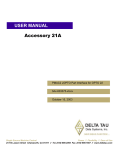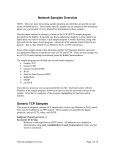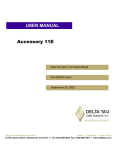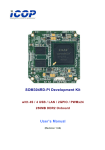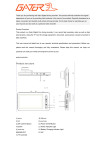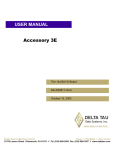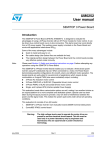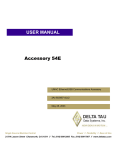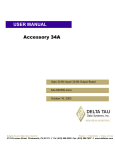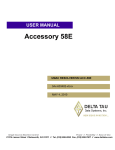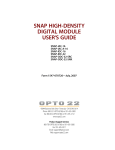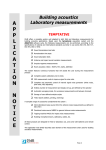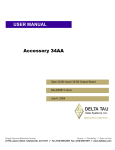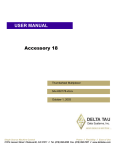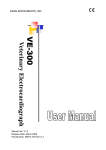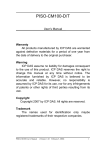Download ^1 USER MANUAL ^2 Accessory 34B
Transcript
^1 USER MANUAL ^2 Accessory 34B ^3 64-Bit Standard I/O Interface Board ^4 3Ax-602375-xUxx ^5 November 7, 2003 Single Source Machine Control Power // Flexibility // Ease of Use 21314 Lassen Street Chatsworth, CA 91311 // Tel. (818) 998-2095 Fax. (818) 998-7807 // www.deltatau.com Copyright Information © 2003 Delta Tau Data Systems, Inc. All rights reserved. This document is furnished for the customers of Delta Tau Data Systems, Inc. Other uses are unauthorized without written permission of Delta Tau Data Systems, Inc. Information contained in this manual may be updated from time-to-time due to product improvements, etc., and may not conform in every respect to former issues. To report errors or inconsistencies, call or email: Delta Tau Data Systems, Inc. Technical Support Phone: (818) 717-5656 Fax: (818) 998-7807 Email: [email protected] Website: http://www.deltatau.com Operating Conditions All Delta Tau Data Systems, Inc. motion controller products, accessories, and amplifiers contain static sensitive components that can be damaged by incorrect handling. When installing or handling Delta Tau Data Systems, Inc. products, avoid contact with highly insulated materials. Only qualified personnel should be allowed to handle this equipment. In the case of industrial applications, we expect our products to be protected from hazardous or conductive materials and/or environments that could cause harm to the controller by damaging components or causing electrical shorts. When our products are used in an industrial environment, install them into an industrial electrical cabinet or industrial PC to protect them from excessive or corrosive moisture, abnormal ambient temperatures, and conductive materials. If Delta Tau Data Systems, Inc. products are directly exposed to hazardous or conductive materials and/or environments, we cannot guarantee their operation. ACC-34B Table of Contents INTRODUCTION .....................................................................................................................................................1 Connectors...................................................................................................................................................................1 J1.............................................................................................................................................................................1 J2.............................................................................................................................................................................1 J3.............................................................................................................................................................................1 J4A (JTHW).............................................................................................................................................................1 J4B ..........................................................................................................................................................................2 TB1 ..........................................................................................................................................................................2 TB2 ..........................................................................................................................................................................2 MULTIPLEX ADDRESS MAP ...............................................................................................................................5 M-Variable Assignments.............................................................................................................................................6 Processing ACC-34x Inputs and Outputs....................................................................................................................7 When to Access ACC-34x...........................................................................................................................................7 Image Word Variables.................................................................................................................................................7 Location of Image Words ........................................................................................................................................7 Preventing Conflicts in Output Image Words .........................................................................................................8 M103 = (M101 & $00000FFF) | (M102 & $FFFFF000) ......................................................................................9 Power Supply and Opto-Isolation Considerations.....................................................................................................11 Watchdog Timer (Role of Jumper E2) ......................................................................................................................12 CONNECTORS.......................................................................................................................................................13 J1 (50 Pin Header) .....................................................................................................................................................13 J2 (50 Pin Header) .....................................................................................................................................................14 J3 (50 Pin Header) .....................................................................................................................................................15 J4A and J4B (26-Pin Header)....................................................................................................................................16 TB1 (2-Pin Terminal Block)......................................................................................................................................17 TB2 (2-Pin Terminal Block)......................................................................................................................................17 SCHEMATICS ........................................................................................................................................................19 Table of Contents i ACC-34B ii Table of Contents ACC-34B INTRODUCTION PMAC's Accessory 34B(ACC-34B) is a discrete input/output (I/O) board designed for easy connection to Opto-22 and compatible mounting racks. The board interfaces with several third party opto modules (e.g. Opto-22 Models G4PB24 & G4PB16H) via standard 50-pin flat cables (see ACC-21 cables). ACC-34B provides 32 lines of optically isolated inputs and 32 lines of optically isolated outputs. Both the inputs and the outputs are TTL compatible negative logic (low true) types. The actual I/O Reads and Writes are carried out using a special form of M-variables which will be described later. ACC-34B is one of a series of I/O accessories for PMAC that use the JTHW connector. Others are: ACC-34 ACC-34A ACC-18 ACC-8D-Opt.7 ACC-8D-Opt.8 The Opto 64 Bit Input/Output board The Opto 32 Bit Input/32 Bit Output board The Thumbwheel Multiplexer board The Resolver to Digital Converter board The Absolute Encoder Interface board All of the above accessories use the JTHW multiplex address scheme and several of them may be daisychained to a single PMAC. In addition for enhanced noise reduction and long distance installation, accessories 35A and 35B provide differential buffer capability for the JTHW signals. The use of the long distance buffer pair (ACC-35A and ACC-35B) is recommended whenever the required cable length between PMAC and ACC-34x is beyond 3 meters (10 feet). Up to 32 ACC-34Bs may be connected to a single PMAC, giving the possible total number of 1024 input and 1024 output lines in addition to those available on the PMAC board and those available on the parallel I/O expansion board(s) (ACC-14). Accessory 34B communicates to PMAC via its JTHW connector through the supplied flat cable. In situations where the I/O modules are a long distance away from PMAC, ACC-35A& ACC-35B may be used as local and remote buffers between PMAC and ACC34B. ACC-34B also supports a local watchdog timer feature independent of that of PMAC's. The mode of operation of this function is explained at the end of this manual (see also the enclosed schematic). Connectors Refer to the layout diagram of ACC-34B for the location of the connectors on the board. A pin definition listing for each connector is provided at the end of this Manual. J1 This is a 50-pin header which provides the connection for the input and the output lines numbered 24 to 31. In addition, on this connector a 5V (maximum 0.5 A) power supply outlet is provided for external logic circuits. J2 This is a 50-pin header which provides the connection for the input lines numbered 0 to 23. In addition, on this connector a 5V (maximum 0.5 A) power supply outlet is provided for external logic circuits. J3 This is a 50-pin header which provides the connection for the output lines numbered 0 to 23. In addition, on this connector a 5V (maximum 0.5 A) power supply outlet is provided for external logic circuits. J4A (JTHW) This is a 26-pin header which provides the link between PMAC's JTHW (J3) and this board. Using the supplied flat cable PMAC's J3 should be connected to J4A. Through this connector PMAC sets the outputs and reads the inputs. In addition, the power for the processor side of the opto-isolation circuitry is provided from the PMAC board through this connector. Introduction 1 ACC-34B J4B This is a 26-pin header which brings out the JTHW signals for the next accessory board on the JTHW multiplex memory map. This connector is pin-to-pin compatible with J4A. TB1 This a 2-pin terminal block through which a 5 volt power supply may be brought in for the optically isolated side of the digital circuitry on ACC34B (50 mA is required). If the same supply is to be brought out for the opto boards via J1 to J3 then, depending on the requirements of the opto boards, the current needed may be considerably higher. Remove jumper E1 if the power is supplied to the board via TB1. Note that with jumper E1 is installed, whenever a 12 to 24 volt supply is brought in from TB2, then TB1 can be used as a 5 volt power source for the logic circuits on the external opto boards (see the enclosed schematic). TB2 This is a 2-pin terminal block through which a 12 to 24 volt unregulated power supply may be brought for the optically isolated side of the digital circuitry on ACC34B. The voltage is reduced to 5V via the on board regulator. Install jumper E1 if the required power is supplied via TB2. Do not supply power through both TB1 and TB2. 2 Introduction .13 in (3.18 mm) TB1 TB2 E1 J1 J2 ACC-34B J3 E2 J4A J4B TP1 OPEN .13 in (3.18 mm) 1 1 11.50in(281.75mm) 2.88in(70.5mm) NEW IDEAS IN MOTION . . . 3 Introduction 1 2 3 4 5 ACC-34B 1 1 TB1 J2 J3 JTHW TP1 J4B J4A E2 J3 To additional ACC-34x PMAC-PC Connecting ACC-34B to PMAC J1 E1 TB2 NEW IDEAS IN MOTION . . . Introduction 4 1 2 3 4 5 OPEN ACC-34B ACC-34B MULTIPLEX ADDRESS MAP Each ACC-34B occupies 8 bytes of address space on the PMAC'S JTHW multiplex memory space. This memory space is 8-bit wide, providing the ability to daisy-chain 32 (256/8) ACC-34Bs together (or a combination of ACC-34Bs, ACC-34As, ACC-34s, ACC-18s and ACC-8D OPT7s). The 5-bit dipswitch, SW1, determines the address of each ACC-34B board on the allocated memory space. Port A, the input port, occupies the base address (i.e. bytes 0, 8, 16 etc.) and Port B, the output port, occupies the base address plus 4 (i.e. bytes 4, 12, 20 etc.). Table 1 shows how SW1 should be set for one or more ACC-34B boards connected to the same PMAC. SW1 Dip Switch Setting BOARD # BYTE # SW1 DIP SWITCH SETTING Port A & Port B 5 4 3 2 1 #1 0&4 ON ON ON ON ON #2 8 & 12 ON ON ON ON OFF #3 16 & 20 ON ON ON OFF ON #4 24 & 28 ON ON ON OFF OFF #5 32 & 36 ON ON OFF ON ON #6 40 & 44 ON ON OFF ON OFF #7 48 & 52 ON ON OFF OFF ON #8 56 & 60 ON ON OFF OFF OFF #9 64 &68 ON OFF ON ON ON #10 72 & 76 ON OFF ON ON OFF #11 80 & 84 ON OFF ON OFF ON #12 88 &92 ON OFF ON OFF OFF #13 96 & 100 ON OFF OFF ON ON #14 104 & 108 ON OFF OFF ON OFF #15 112 & 116 ON OFF OFF OFF ON #16 120 & 124 ON OFF OFF OFF OFF #17 128 & 132 OFF ON ON ON ON #18 136 & 140 OFF ON ON ON OFF #19 144 & 148 OFF ON ON OFF ON #20 152 & 156 OFF ON ON OFF OFF #21 160 & 164 OFF ON OFF ON ON #22 168 & 172 OFF ON OFF ON OFF #23 176 & 180 OFF ON OFF OFF ON #24 184 &188 OFF ON OFF OFF OFF #25 192 & 196 OFF OFF ON ON ON #26 200 & 204 OFF OFF ON ON OFF #27 208 & 212 OFF OFF ON OFF ON #28 216 & 220 OFF OFF ON OFF OFF #29 224 & 228 OFF OFF OFF ON ON #30 232 & 236 OFF OFF OFF ON OFF #31 240 & 244 OFF OFF OFF OFF ON #32 248 & 252 OFF OFF OFF OFF OFF The daisy-chain board address relationship with respect to the 5-bit (SW1) DIP position setting. Note: ON=CLOSED, OFF=OPEN. To turn off a switch, push down on the open side. To turn on a switch, push down on the numbered side. Multiplex Address Map 5 ACC-34B M-Variable Assignments Port A is always configured as a negative logic input port which can be read through TWS type Mvariables (see below). The output lines are driven by writing to port B. There is a special format 32-bit wide M-variable for reading the data from, and writing the data to, an ACC-34B card TWS. Note This special M-variable definition is implemented in PMAC's firmware with a version number equal to or higher than 1.13. In version 1.14D, the TWS format was modified in its address designation field to prevent un-intentional reads from an output port or unintentional writes to an input port. If your PROM version is between 1.13 to 1.14C, you may request for a free PROM update to version 1.14D or above. The definition format is of the form: M{constant}->TWS:{m-plex} For an input port, {m-plex} is a legal byte number (from column 2 of Table 1) plus 1. Any attempt to write to a TWS type M-variable defined with bit zero of its address set to 1, is automatically prevented by PMAC's firmware. For an output port, {m-plex} is a legal byte number (from column 2 of Table 1) plus 2. An attempt to read a TWS type M-variable defined with bit one of its address set to 1, returns zero and the actual read is prevented by PMAC's firmware (no error is reported). Note that individual bits cannot be directly assigned to an M-variable of this type. Rather banks of 32 bits (ports) can be assigned to M-variables. For example to address Port A (bits 0 to 31) of board #1 as an input using M100, we would use the following definition: M100->TWS:1 ON ;Port A (AIO 0-31) of an ACC-34B with SW1 switches all ;assigned for read only (1=0+1) Similarly to address Port B of the same board #1 as an output using M101, we would use the following definition: WARNING TWS type M-variable definition addresses which point to the base address directly (e.g. M300->TWS:40) are still valid (i.e. they do not generate error). However their use is very strongly discouraged. This because both reads and writes are enabled when the least significant and the next least significant addresses bits are both zero (e.g. decimal 40 = 01000000 in binary). In this situation, any accidental read of an output port (say via the Executive programs watch window) will cause all the output to be turned on! It is therefore safer and more predictable when bits 0 & 1 of the M-variable definition are intentionally used to disable either the read function or the write function. M101->TWS:6 ;Port B (BIO 0-31) of an ACC-34B with SW1 switches ;all ON assigned for write only (6=4+2) Yet another example: to address Port A of board #6 as an input using M300, we would use the following definition: M300->TWS:41 6 ;Port A (AIO 0-31) of an ACC-34B with SW1 switches ;ON,ON,OFF,ON,OFF assigned for read only (41=40+1) Multiplex Address Map ACC-34B Note A 32-bit Read or a 32-bit Write to an individual port takes approximately 64 microseconds of time in the PMAC's background time slot. As a result excessive and unnecessary references to TWS type M-variables is not recommended (see below for efficient ACC-34x I/O processing). Processing ACC-34x Inputs and Outputs Because the PMAC interface to the Accessory 34 family of I/O boards (ACC-34x) is by full 32-bit words transmitted serially, even when access to only a single bit is desired, the user must consider carefully how the interface is done and how frequently. Care must also be taken to work efficiently with the data so that PMAC is not bogged down with slow serial reads and writes, and time-consuming logic to assemble and disassemble I/O words. The recommended strategy is to keep "images" of each input or output word in PMAC's internal memory, or in the dual-ported RAM. The input words are copied into their image words, and the output words are copied from their image words. Most program operations deal with these image words; much less frequently is the slow transfer to or from an ACC-34x board performed. During the act of copying, bit inversion can also be performed with the exclusive-or function. When to Access ACC-34x The actual reads and writes for an ACC-34x board can only be done in a background PLC program (PLC 1-31) or through on-line commands, which are executed between PLC programs. Motion programs and PLC 0 cannot directly access this I/O -- they can work only with the image words. Reading an input word from an ACC-34x is simply a question of using the TWS-form M-variable for that word on the right side of an equation. Usually this operation simply copies the input word into its internal image variable. Similarly, writing an output word to an ACC-34x just involves using the M-variable for that word on the left side of an equation, typically just copying it from its internal image word. Most users will treat ACC-34x I/O the same way that a traditional PLC treats its I/O; all of the inputs are read at the beginning of a PLC software scan, and all of the outputs are written to at the end of the scan. In between, all the processing of the variables is done working with the internal image words. It is possible to make the write operation to the output word conditional on a change in the image word for the output from the previous scan, but the time involved in making the decision and storing each scan's value is about the same as the actual writing to the output. Image Word Variables It is best to use fixed-point M-variables as the internal image variables for the I/O words. When this is done, a single M-variable representing the entire I/O word can be used for the copying operation. Then separate M-variables can be used to access individual bits or segments of the image word. Use of these smaller M-variables allows PMAC's efficient firmware to do the masking and logic necessary to pick out portions of the I/O word, rather than slower user program code. Location of Image Words Where should these internal image variables reside in PMAC's memory? If the system has dual-ported RAM, it is probably best to use a 32-bit register in DPRAM. This way, the host computer always has immediate access to the I/O. In fact, it is possible to use PMAC just as a pass-through between the host computer and the ACC-34x boards, letting the host computer do all the processing. A 32-bit fixed-point register in DPRAM is defined by the DP format of M-variable (e.g. M60-> DP:$DF00). This type of variable occupies the low 16 bits (bits 0 to 15) of PMAC Y-memory, and the low 16 bits of PMAC Xmemory at the same address, with the less significant bits in Y-memory. It appears to the host computer as 2 16-bit registers at consecutive even addresses, with the less significant bits at the lower address. Multiplex Address Map 7 ACC-34B If there is no DPRAM, the image word will be in an otherwise unused double register in PMAC's own memory. There are several places to find unused registers. There are sixteen open registers that are automatically set to zero on power-up at PMAC addresses $0770 to $077F. There are sixteen more open registers whose values are held when power is off at PMAC addresses $07F0 to $07FF. Also, it is possible to use the registers of otherwise unused P and Q-variables for this purpose. These registers should be accessed with fixed-point M-variables, not floating-point P or Q-variables! A double fixed-point register in PMAC's internal memory is defined by the D format of M-variable (e.g. M61->D:$07F0). This is a 48-bit register -- only the low 32 bits will be used. The low 24 bits of the I/O will be in Y-memory, and the high 8 bits of the I/O will be in the low 8 bits of X-memory. When working with the ACC-34x I/O with this method of using fixed-point image variables, the only software overhead is the actual copying between image and I/O. Including program interpretation time, this amounts to about 100 microseconds per 32-bit word. Aside from this, working with the I/O through the image words is at least as fast as direct (parallel) PMAC I/O. Of course, there is a potential latency of a full PLC scan on the actual I/O which must be respected. Many systems will have a few critical I/O points that cannot tolerate this latency; these typically use PMAC's JOPTO port or ACC-14 I/O for these time-critical points, then use ACC-34x for I/O that do not need to be so fast. Preventing Conflicts in Output Image Words Care must be taken if tasks of different priority levels are trying to write to the same output image word, or if both the host computer and PMAC are trying to write to the same DPRAM output image word. If the proper techniques are not used, occasional output changes will not be executed, and because of the intermittent nature of the problem will make it very difficult to diagnose. If the application has two priority levels or two computers that write to the same ACC-34x output word, separate partial image words must be used, then these words combined as the output word is sent. Note that there is no conflict in having different tasks or different processors read from the same input word. Remember that a computer cannot actually write to less than a word of memory at a time, even if it only wants to change one bit. In PMAC the word length is 24 bits; for the DPRAM, it is 16 bits. If a computer wants to change less than a full word, it must read the full word, modify the bits it wants with mask words, and then write back the full word. There are two priority levels in PMAC that can write to these image words: the foreground level, which includes all of the motion programs and PLC 0; and the background level, which includes PLCs 1-31 and on-line commands. The problem can occur when a higher priority task interrupts a lower priority task that is in the middle of changing the image word with a read-modify-write operation. When the lower priority task resumes, it will undo the changes made by the higher priority task. Similarly, if the image word is in the DPRAM, and one side starts its read-modify-write cycle on the word but does not finish it before the other side starts its own cycle, the side that starts later can undo the changes made by the side that starts first. (Note that two tasks at the same priority level cannot interrupt each other; one will always finish an operation before the other starts. Therefore, there is no need to worry about two motion programs writing to the same image word; or a motion program and PLC 0; because these tasks are at the same priority level. Similarly, there is no need to worry about two background PLC programs writing to the same image word, or a background PLC and on-line commands.) To prevent this possible conflict, the different priority levels or different processors must use different image words, even if they each represent only a part of the same total output word. These partial words are then combined in the act of writing to the actual output word. The simplest way to split an image word is to use the natural X-memory vs. Y-memory split in PMAC's memory. If you are using a double word in PMAC's internal memory, you can reserve the 24 bits in Y8 Multiplex Address Map ACC-34B memory for one priority level, and the 8 bits in X-memory for the other. If you are using the DPRAM, you can reserve the 16 bits in Y-memory for one processor or priority level, and the 16 bits in X-memory for another. If you do this, no special techniques need to be used. On PMAC, simply write to the partial words with a X or Y format M-variable; PMAC will automatically do the read-modify-write cycle without touching the other part of the word. On the host computer, access the DPRAM register with the short (16-bit) integer format, not the long. However, if you cannot arrange your split in this fashion, you must create separate "overlapping" image words and explicitly combine them. As an example, take a system where the low 12 bits will be written to by background PLCs and the high 20 bits will be written to by motion programs. We create two separate image words, one for each priority level, and the actual output word: M101->D:$0770 M102->D:$0771 M103->TWS:6 ; Image word for PLC programs (background) ; Image word for motion programs (foreground) ; ACC-34x output word; write-only We also define single-bit M-variables to parts of these same internal addresses: at Y:$0770, bits 0 to 11 for the PLCs; then at Y:$0771, bits 12 to 23, and X:$0771, bits 0 to 7 for the motion programs. At the end of a PLC scan, to create the actual output word on an ACC-34x from the image words, we would use the program statement: M103 = (M101 & $00000FFF) | (M102 & $FFFFF000) The bit-by-bit AND (&) operations make sure no falsely set bits in unused portions of the image words get into the output word. They are not strictly necessary if the unused bits can be guaranteed to be zero. The bit-by-bit OR (|) operation combines the word, and the assignment of the resulting value to M103 causes it to be written to the ACC-34x. If you want to be able to write to the same bit of an output image word with two different priority levels or processors, one of the tasks must do so indirectly by writing into a holding register. The other task must take this holding register and transfer the bit value into the image word. This task must decide what to do in case of any conflict (i.e. one task wants to clear the bit, and the other wants to set it). Example: The following example should illustrate the concept of this method of working with ACC-34x I/O. It is a bit unrealistic, because it shows the image variables both in DPRAM and several places in internal memory. In a real application, a single location range would probably be chosen. Set-up and Definitions: M1000->TWS:1 M1002->TWS:6 M1004->TWS:9 M1006->TWS:14 Multiplex Address Map ; ; ; ; ; ; ; ; ; ; ; ; ; ; ; ; Actual ACC-34 I/O Words First side of first ACC-34x board an Location is at port address 0; added read only Second side of first ACC-34x board an output here Location is at port address 4; added write only First side of second ACC-34x board an input here Location is at port address 8; added read only Second side of second ACC-34x board an output here Location is at port address 12 added 2 for write only input here 1 for 2 for 1 for 9 ACC-34B M1001->DP:$D800 M1003->D:$0770 M1005->D:$07F0 M1007->D:$13FF M100->Y:$D800,0 M101->Y:$D800,1 ... M115->Y:$D800,15 M116->X:$D800,0 M117->X:$D800,1 ... M131->X:$D800,15 M300->Y:$0770,0 M301->Y:$0770,1 ... M323->Y:$0770,23 M324->X:$0770,0 M325->X:$0770,1 ... M331->X:$0770,7 M500->Y:$07F0,0 ... M523->Y:$07F0,23 M524->X:$07F0,0 ... M531->X:$07F0,7 M700->Y:$13FF,0 ... M724->X:$13FF,0,8 10 ; ; ; ; ; ; ; ; Image Words 32-bit fixed-point DPRAM register 48-bit fixed-point register, set to zero on power-up 48-bit fixed-point register, value held thru power down Register for P1023, treated as 48-bit fixedpoint value ; ; ; ; Individual Pieces of Image Words Least significant bit (bit 0) of first image word Second bit (bit 1) of first image word ; Bit 15 of first image word ; Bit 16 of first image word ; ; ; ; ; Most significant bit (bit 31) of first image word Least significant bit (bit 0) of second image word Second bit (bit 1) of second image word ; Bit 23 of second image word ; Bit 24 of second image word ; Bit 25 of second image word ; ; ; ; Most significant bit (bit 31) of second image word Least significant bit (bit 0) of third image word ; Bit 23 of third image word ; Bit 24 of third image word ; ; ; ; Most significant bit (bit 31) of third image word Least significant bit (bit 0) of fourth image word ; Top eight bits (bits 24-31) of fourth ; image word Multiplex Address Map ACC-34B Programs: ; "Reset" PLC program that only runs once on ; power-up or reset OPEN PLC 1 CLEAR M1003=0 M1007=0 ... DISABLE PLC 1 ; Clear output image word to make sure all ; outputs off ; Ditto ; To make sure this only runs once on ; power-up/reset CLOSE ; PLC program to copy the inputs into image words at beginning of each scan OPEN PLC 2 CLEAR M1001=M1000 ; Copy first input word into its image register M1005=M1004^$FFFFFFFF ; Copy second input word into its image register, ; inverting ... CLOSE ; PLC program that works with individual bits of ; image words OPEN PLC 3 CLEAR IF (M100=1 AND M101=0 AND P43>50) M301=1 ELSE M301=0 ENDIF ... CLOSE ; PLC program that copies image words to outputs ; at end of scan OPEN PLC 31 CLEAR M1002=M1003 M1004=M1005^$FFFFFFFF ; Copy first output image word to ACC-34x ; Copy second output image word to ACC-34x, ; inverting Power Supply and Opto-Isolation Considerations The power for the PMAC processor side of the opto-isolation circuitry is brought in directly from J1 (JTHW). The power for the external side of the opto-isolation circuitry should be from a separate supply brought in through TB1 (5V) or TB2 (12-24V). Note either TB1 or TB2 should be used. Do not supply power through both TB1 and TB2. E1 should be installed when +12 to 24V supply is brought in through TB2. It should be removed if +5V supply is brought in through TB1. The current requirement for on board logic circuit on the external side of the opto isolation is approximately 50 mA. However, if the power is also supplied for the external opto boards digital circuits, then up to 550 mA may be required. Multiplex Address Map 11 ACC-34B Watchdog Timer (Role of Jumper E2) ACC-34B has a local watchdog timer which is enabled unless the jumper E2 is removed. In the default factory setup this jumper is installed. A 1.5 second period watchdog timer circuitry is enabled on ACC34A when jumper E2 is installed. When the timer is enabled, if PMAC (either through a PLC program or a motion program) does not read from or write to the ACC-34B board at least once per 1.5 second the watchdog timer trips. When this occurs the outputs go high which in turn switches off the outputs of opto board(s) connected to ACC-34B. 12 Multiplex Address Map ACC-34B CONNECTORS J1 (50 Pin Header) Pin # Symbol 1 2 3 4 5 6 7 8 9 10 11 12 13 14 15 16 17 18 19 20 21 22 23 24 25 26 27 28 29 30 31 32 33 34 35 36 37 38 39 40 41 42 43 44 45 46 N.C GND N.C. GND N.C GND N.C GND N.C GND N.C GND N.C GND N.C GND OUT31 GND OUT30 GND OUT29 GND OUT28 GND OUT27 GND OUT26 GND OUT25 GND OUT24 GND IN31 GND IN30 GND IN29 GND IN28 GND IN27 GND IN26 GND IN25 GND Connectors Function Description Notes Not connected Common Opto Common Common Opto Common Common Opto Common Common Opto Common Not connected Not connected Not connected Not connected Common Opto Common Common Opto Common Common Opto Common Common Output Common Output Common Output Common Output Common Output Common Output Common Output Common Output Common Input Common Input Common Input Common Input Common Input Common Input Common Input Common Opto Common Port B Bit 31 Opto Common Port B Bit 30 Opto Common Port B Bit 29 Opto Common Port B Bit 28 Opto Common Port B Bit 27 Opto Common Port B Bit 26 Opto Common Port B Bit 25 Opto Common Port B Bit 24 Opto Common Port A Bit 31 Opto Common Port A Bit 30 Opto Common Port A Bit 29 Opto Common Port A Bit 28 Opto Common Port A Bit 27 Opto Common Port A Bit 26 Opto Common Port A Bit 25 Opto Common Not connected Not connected Not connected 13 ACC-34B 47 48 49 50 IN24 GND A +5V GND Input Common Output Common Port A Bit 24 Opto Common +5V supply Opto Common See J1, TB1 & TB2 description J2 (50 Pin Header) 14 Pin # Symbol Function Description 1 2 3 4 5 6 7 8 9 10 11 12 13 14 15 16 17 18 19 20 21 22 23 24 25 26 27 28 29 30 31 32 33 34 35 36 37 38 39 40 41 42 43 IN23 GND IN22 GND IN21 GND IN20 GND IN19 GND IN18 GND IN17 GND IN16 GND IN15 GND IN14 GND IN13 GND IN12 GND IN11 GND IN10 GND IN9 GND IN8 GND IN7 GND IN6 GND IN5 GND IN4 GND IN3 GND IN2 Input Common Input Common Input Common Input Common Input Common Input Common Input Common Input Common Input Common Input Common Input Common Input Common Input Common Input Common Input Common Input Common Input Common Input Common Input Common Input Common Input Common Input Port A Bit 23 Opto Common Port A Bit 22 Opto Common Port A Bit 21 Opto Common Port A Bit 20 Opto Common Port A Bit 19 Opto Common Port A Bit 18 Opto Common Port A Bit 17 Opto Common Port A Bit 16 Opto Common Port A Bit 15 Opto Common Port A Bit 14 Opto Common Port A Bit 13 Opto Common Port A Bit 12 Opto Common Port A Bit 11 Opto Common Port A Bit 10 Opto Common Port A Bit 9 Opto Common Port A Bit 8 Opto Common Port A Bit 7 Opto Common Port A Bit 6 Opto Common Port A Bit 5 Opto Common Port A Bit 4 Opto Common Port A Bit 3 Opto Common Port A Bit 2 Notes Connectors ACC-34B 44 45 46 47 48 49 50 GND IN1 GND IN0 GND A +5V GND Common Input Common Input Common Output Common Opto Common Port A Bit 1 Opto Common Port A Bit 0 Opto Common +5 V supply Opto Common See J1, TB1 & TB2 description J3 (50 Pin Header) Pin # Symbol Function Description 1 2 3 4 5 6 7 8 9 10 11 12 13 14 15 16 17 18 19 20 21 22 23 24 25 26 27 28 29 30 31 32 33 34 35 36 37 38 39 40 OUT23 GND OUT22 GND OUT21 GND OUT20 GND OUT19 GND OUT18 GND OUT17 GND OUT16 GND OUT15 GND OUT14 GND OUT13 GND OUT12 GND OUT11 GND OUT10 GND OUT9 GND OUT8 GND OUT7 GND OUT6 GND OUT5 GND OUT4 GND Output Common Output Common Output Common Output Common Output Common Output Common Output Common Output Common Output Common Output Common Output Common Output Common Output Common Output Common Output Common Output Common Output Common Output Common Output Common Output Common Port B Bit 23 Opto Common Port B Bit 22 Opto Common Port B Bit 21 Opto Common Port B Bit 20 Opto Common Port B Bit 19 Opto Common Port B Bit 18 Opto Common Port B Bit 17 Opto Common Port B Bit 16 Opto Common Port B Bit 15 Opto Common Port B Bit 14 Opto Common Port B Bit 13 Opto Common Port B Bit 12 Opto Common Port B Bit 11 Opto Common Port B Bit 10 Opto Common Port B Bit 9 Opto Common Port B Bit 8 Opto Common Port B Bit 7 Opto Common Port B Bit 6 Opto Common Port B Bit 5 Opto Common Port B Bit 4 Opto Common Connectors Notes 15 ACC-34B 41 42 43 44 45 46 47 48 49 50 OUT3 GND OUT2 GND OUT1 GND OUT0 GND A +5V GND Output Common Output Common Output Common Output Common Output Common Port B Bit 3 Opto Common Port B Bit 2 Opto Common Port B Bit 1 Opto Common Port B Bit 0 Opto Common +5 V supply Opto Common See J1, TB1 & TB2 description J4A and J4B (26-Pin Header) 16 Pin # Symbol Function Description 1 2 3 4 5 6 7 8 9 10 11 12 13 14 15 16 17 18 19 20 21 22 23 24 25 26 GND GND DAT0 SEL0 DAT1 SEL 1 DAT2 SEL2 DAT3 SEL3 DAT4 SEL 4 DAT5 SEL5 DAT6 SEL6 DAT7 SEL7 N.C. GND N.C. GND N.C. GND +5V N.C. Common Common Output Input Output Input Output Input Output Input Output Input Output Input Output Input Output Input PMAC Common PMAC Common Data Bit 0 Address Line 0 Data Bit 1 Address Line 1 Data Bit 2 Address Line 2 Data Bit 3 Address Line 3 Data Bit 4 Address Line 4 Data Bit 5 Address Line 5 Data Bit 5 Address Line 6 Data Bit 6 Data Bit 7 Notes Not connected Not connected Not connected Not connected Not connected Not connected Not connected Not connected Common PMAC Common Common PMAC Common Common Input PMAC Common +5V DC Supply Not connected Not connected Not connected Connectors ACC-34B TB1 (2-Pin Terminal Block) Pin # Symbol Function Description Notes 1 AGND Common 2 A+5V Power Supply External Supply Ground External Supply for Optically Isolated Part of Circuitry Regulated +5V This a 2-pin terminal block through which a 5 volt power supply may be brought in for the optically isolated side of the digital circuitry on ACC34B (50 mA is required). If the same supply is to be brought out for the opto boards via J1 to J3 then, depending on the requirements of the opto boards, the current needed may be considerably higher. Remove jumper E1 if the power is supplied to the board via TB1. Note that with jumper E1 is installed, whenever a 12 to 24V supply is brought in from TB2, then TB1 can be used as a 5V power source for the logic circuits on the external opto boards (see the enclosed schematic). TB2 (2-Pin Terminal Block) Pin # Symbol Function Description 1 AGND Common 2 A+24V Power Supply External Supply Ground External Supply for Optically Isolated Part of Circuitry Notes 12V to 24V Unregulated This is a 2-pin terminal block through which a 12 to 24V unregulated power supply may be brought for the optically isolated side of the digital circuitry on ACC34B. The voltage is reduced to 5V via the on board regulator. Install jumper E1 if the required power is supplied via TB2. Do not supply power through both TB1 and TB2. Connectors 17 ACC-34B 18 Connectors ACC-34B SCHEMATICS Schematics 19























